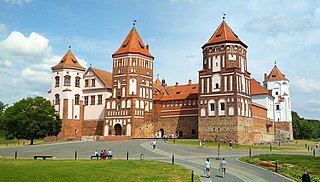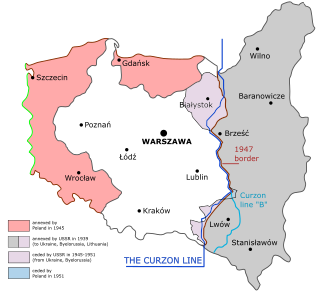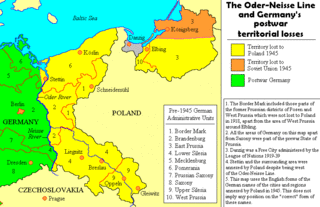
Grodno Region or Hrodna Region, also known as Grodno Oblast or Hrodna Voblasts, is one of the regions of Belarus. Its administrative center, Grodno, is the largest city in the region.
The Poles come from different West Slavic tribes living on territories belonging later to Poland in the early Middle Ages.

Seventeen days after the German invasion of Poland in 1939, which marked the beginning of the Second World War, the Soviet Union entered the eastern regions of Poland and annexed territories totalling 201,015 square kilometres (77,612 sq mi) with a population of 13,299,000. Inhabitants besides ethnic Poles included Belarusian and Ukrainian major population groups, and also Czechs, Lithuanians, Jews, and other minority groups.

The Republic of Central Lithuania, commonly known as the Central Lithuania, and the Middle Lithuania, was an unrecognized short-lived puppet republic of Poland, that existed from 1920 to 1922. It was founded on 12 October 1920, after Żeligowski's Mutiny, when soldiers of the Polish Army, mainly the 1st Lithuanian–Belarusian Infantry Division under Lucjan Żeligowski, fully supported by the Polish air force, cavalry and artillery, attacked Lithuania. It was incorporated into Poland on 18 April 1922.

The Treaty of Riga was signed in Riga, Latvia, on 18 March 1921 between Poland on one side and Soviet Russia and Soviet Ukraine on the other, ending the Polish–Soviet War (1919–1921). The chief negotiators of the peace were Jan Dąbski for the Polish side and Adolph Joffe for the Soviet side.

Eastern Borderlands or simply Borderlands was a term coined for the eastern part of the Second Polish Republic during the interwar period (1918–1939). Largely agricultural and extensively multi-ethnic with a Polish minority, it amounted to nearly half of the territory of interwar Poland. Historically situated in the eastern Polish–Lithuanian Commonwealth, following the 18th-century foreign partitions it was divided between the Empires of Russia and Austria-Hungary, and ceded to Poland in 1921 after the Treaty of Riga. As a result of the post-World War II border changes, all of the territory was ceded to the USSR, and none of it is in modern Poland.

At the end of World War II, Poland underwent major changes to the location of its international border. In 1945, after the defeat of Nazi Germany, the Oder–Neisse line became its western border, resulting in gaining the Recovered Territories from Germany. The Curzon Line became its eastern border, resulting in the loss of the Eastern Borderlands to the Soviet Union.

Western betrayal is the view that the United Kingdom, France, and sometimes the United States failed to meet their legal, diplomatic, military, and moral obligations with respect to the Czechoslovak and Polish states during the prelude to and aftermath of World War II. It also sometimes refers to the treatment of other Central and Eastern European states at the time.

The Wilno Voivodeship was one of 16 Voivodeships in the Second Polish Republic, with the capital in Wilno. The jurisdiction was created in 1926 and populated predominantly by Poles, with notable minorities of Belarusians, Jews and Lithuanians. Before 1926, the voivodeship's area was known as the Wilno Land; it had the same boundaries and was also within the contemporary borders of Poland at the time.
The city of Vilnius, now the capital of Lithuania, and its surrounding region has been under various states. The Vilnius Region has been part of the Grand Duchy of Lithuania from the Lithuanian state's founding in the late Middle Ages to its destruction in 1795, i.e. five centuries. From then, the region was occupied by the Russian Empire until 1915, when the German Empire invaded it. After 1918 and throughout the Lithuanian Wars of Independence, Vilnius was disputed between the Republic of Lithuania and the Second Polish Republic. After the city was seized by the Republic of Central Lithuania with Żeligowski's Mutiny, the city was part of Poland throughout the Interwar period. Regardless, Lithuania claimed Vilnius as its capital. During World War II, the city changed hands many times, and the German occupation resulting in the destruction of Jews in Lithuania. From 1945 to 1990, Vilnius was the Lithuanian Soviet Socialist Republic's capital. From the dissolution of the Soviet Union, Vilnius has been part of Lithuania.

Vilnius Region is the territory in present-day Lithuania and Belarus that was originally inhabited by ethnic Baltic tribes and was a part of Lithuania proper, but came under East Slavic and Polish cultural influences over time.

Western Belorussia or Western Belarus is a historical region of modern-day Belarus which belonged to the Second Polish Republic during the interwar period. For twenty years before the 1939 invasion of Poland, it was the northern part of the Polish Kresy macroregion. Following the end of World War II in Europe, most of Western Belorussia was ceded to the Soviet Union by the Allies, while some of it, including Białystok, was given to the Polish People's Republic. Until the dissolution of the Soviet Union in 1991, Western Belorussia formed the western part of the Byelorussian Soviet Socialist Republic (BSSR). Today, it constitutes the west of modern Belarus.

Subdivision of Polish territories during World War II can be divided into several phases. The territories of the Second Polish Republic were first administered first by Nazi Germany and the Soviet Union, then in their entirety by Nazi Germany, and finally by the Soviet Union again. In 1946, administrative control of the areas not annexed by the Soviet Union was returned to Poland.

Żeligowski's Mutiny was a Polish false flag operation led by General Lucjan Żeligowski in October 1920, which resulted in the creation of the Republic of Central Lithuania. Józef Piłsudski, the Chief of State of Poland, surreptitiously ordered Żeligowski to carry out the operation, and revealed the truth only several years afterwards.

The Polish population transfers in 1944–1946 from the eastern half of prewar Poland, were the forced migrations of Poles toward the end and in the aftermath of World War II. These were the result of a Soviet Union policy that had been ratified by the main Allies of World War II. Similarly, the Soviet Union had enforced policies between 1939 and 1941 which targeted and expelled ethnic Poles residing in the Soviet zone of occupation following the Nazi-Soviet invasion of Poland. The second wave of expulsions resulted from the retaking of Poland from the Wehrmacht by the Red Army. The USSR took over territory for its western republics.

The population exchange between Poland and Soviet Ukraine at the end of World War II was based on a treaty signed on 9 September 1944 by the Ukrainian SSR with the newly-formed Polish Committee of National Liberation (PKWN). The exchange stipulated the transfer of ethnic Ukrainians to the Ukrainian SSR and of ethnic Poles and Jews who had Polish citizenship before September 17, 1939 to post-war Poland, in accordance with the resolutions of the Yalta and Tehran conferences and the plans about the new Poland–Ukraine border. Similar agreements were signed with the Byelorussian SSR and the Lithuanian SSR ; the three documents are commonly known as the Republican Agreements.

The Border Agreement between Poland and the USSR of 16 August 1945 established the borders between the Union of Soviet Socialist Republics (USSR) and the Republic of Poland. It was signed by the Provisional Government of National Unity formed by the Polish communists. According to the treaty, Poland officially accepted the ceding its pre-war Eastern territory to the USSR (Kresy) which was decided earlier in Yalta already. Some of the territory along the Curzon line, established by Stalin during the course of the war, was returned to Poland. The treaty also recognised the division of the former German East Prussia and ultimately approved the finalised delimitation line between the Soviet Union and Poland: from the Baltic sea, to the border tripoint with Czechoslovakia in the Carpathians. The agreement entered into force on 5 February 1946.

The Oder–Neisse line is an unofficial term for the modern border between Germany and Poland. The line generally follows the Oder and Lusatian Neisse rivers, meeting the Baltic Sea in the north. A small portion of Polish territory does fall west of the line, including the cities of Szczecin and Świnoujście.

Zakerzonia is an informal name for the territories of Poland to the west of the Curzon Line which used to have sizeable Ukrainian populations, including significant Lemko, Boyko populations, before the invasion of Poland by the Soviet Union and Nazi Germany in 1939, and were claimed as ethnically Ukrainian territories by Ukrainian nationalists in the aftermath of World War II. However, before 1939, the areas of Zakerzonia were mostly inhabited by Poles, who constituted about 70% of the population of this area. Ukrainians lived in a minority in Zakerzonia, constituting about 20% of the area's population.

The flight and forced displacement of Poles from all territories east of the Second Polish Republic (Kresy) pertains to the dramatic decrease of Polish presence on the territory of the post-war Soviet Union in the first half of the 20th century. The greatest migrations took place in waves between the Bolshevik Revolution of 1917 and in the aftermath of World War II in Europe.























